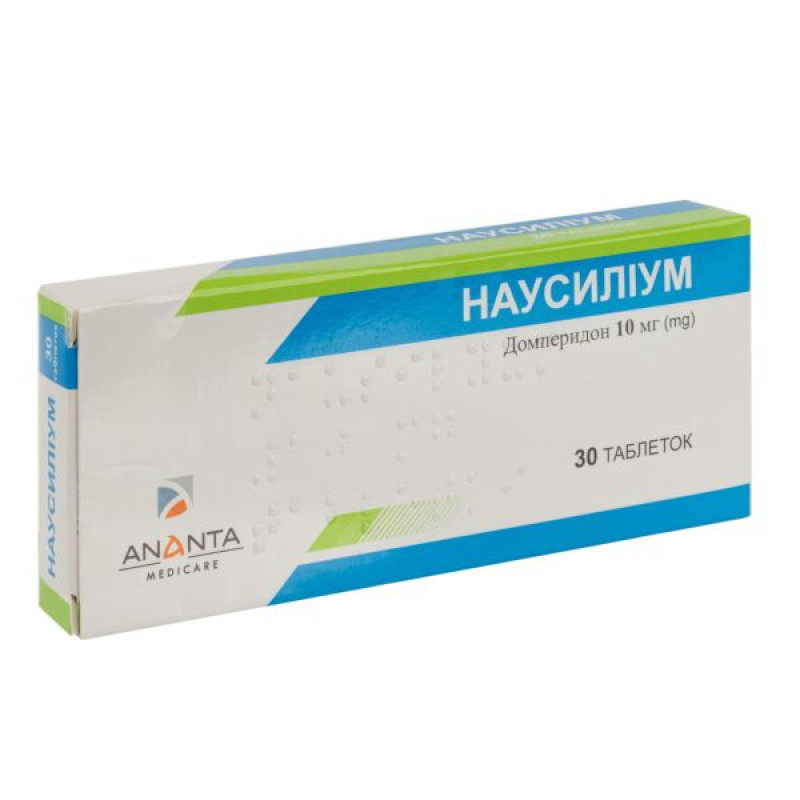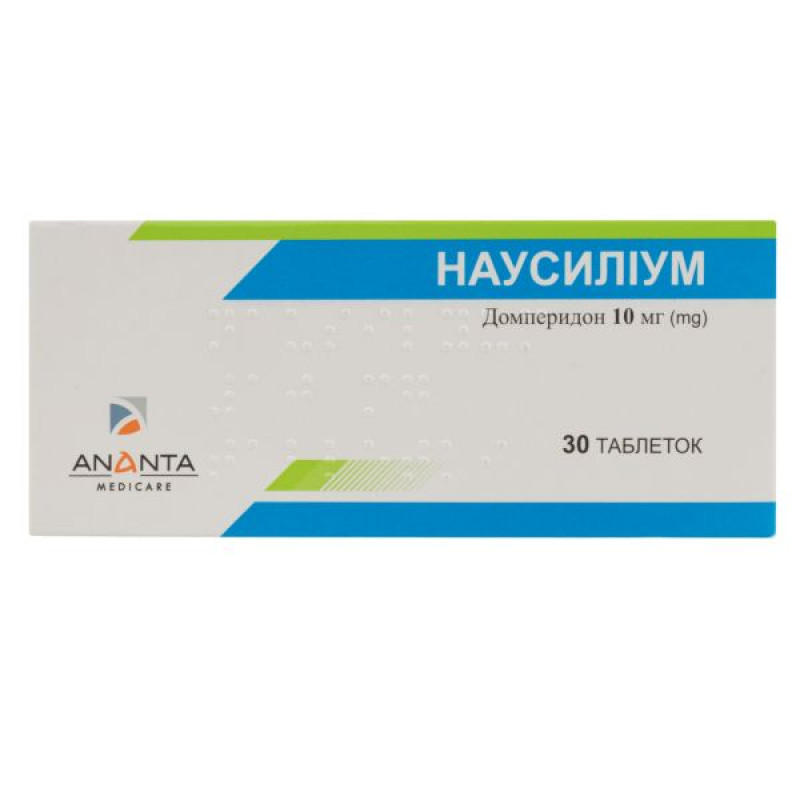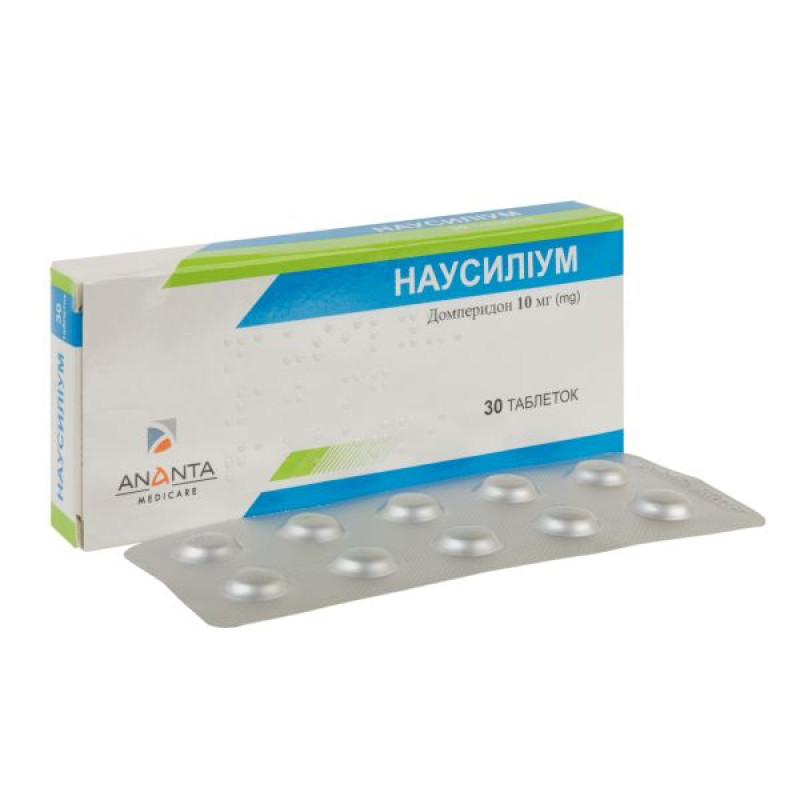Nausilium tablets 10 mg No. 30

Instructions for Nausilium tablets 10 mg No. 30
Composition
active ingredient: domperidone;
1 tablet contains domperidone maleate equivalent to 10 mg domperidone;
Excipients: lactose monohydrate; corn starch; povidone K-30; microcrystalline cellulose; sodium lauryl sulfate; magnesium stearate; colloidal anhydrous silicon dioxide.
Dosage form
Pills.
Main physicochemical properties: round biconvex tablets of white or almost white color.
Pharmacotherapeutic group
Drugs used in functional gastrointestinal disorders. Peristalsis stimulants. ATX code A03F A03.
Pharmacological properties
Pharmacodynamics
Domperidone is a dopamine antagonist with antiemetic properties. Domperidone crosses the blood-brain barrier to a limited extent. Extrapyramidal side effects are very rare with domperidone, especially in adults, but domperidone stimulates the release of prolactin from the pituitary gland. Its antiemetic effect is probably due to a combination of peripheral (gastrokinetic) action and antagonism of dopamine receptors in the chemoreceptor trigger zone, which is located outside the blood-brain barrier in the area postrema. Animal studies, as well as low concentrations determined in the brain, indicate a predominantly peripheral effect of domperidone on dopamine receptors.
Studies in humans have shown that when administered orally, domperidone increases lower esophageal pressure, improves antroduodenal motility, and accelerates gastric emptying. Domperidone does not affect gastric secretion.
Pharmacokinetics
Domperidone is rapidly absorbed after oral administration on an empty stomach, with peak plasma concentrations occurring approximately 30-60 minutes after administration. The low absolute bioavailability of oral domperidone (approximately 15%) is due to extensive first-pass metabolism in the intestinal wall and liver. Although in healthy subjects the bioavailability of domperidone is increased after administration after a meal, patients with gastrointestinal complaints should take domperidone 15-30 minutes before a meal. Reduced gastric acidity reduces the absorption of domperidone. Oral bioavailability is reduced after prior administration of cimetidine or sodium bicarbonate. When administered orally after a meal, maximum absorption is slightly delayed and the area under the curve (AUC) is slightly increased.
When administered orally, domperidone does not accumulate and does not induce its own metabolism; the maximum plasma level after 90 min (21 ng/ml) after two weeks of oral administration of 30 mg per day was almost the same as after the first dose (18 ng/ml). Domperidone is 91-93% bound to plasma proteins. Distribution studies of domperidone conducted in animals using a radioactive isotope-labeled drug showed its extensive distribution in tissues, but low concentrations in the brain. In animals, small amounts of the drug penetrate the placenta.
Domperidone is rapidly and extensively metabolized in the liver by hydroxylation and N-dealkylation. In vitro metabolism studies with a diagnostic inhibitor have shown that CYP3A4 is the major cytochrome P450 involved in N-dealkylation, while CYP3A4, CYP1A2 and CYP2E1 are involved in the aromatic hydroxylation of domperidone.
Urinary and fecal excretion account for 31% and 66% of the oral dose, respectively. Excretion of unchanged drug is small (10% in feces and approximately 1% in urine). The plasma half-life after a single dose is 7-9 hours in healthy volunteers, but is prolonged in patients with severe renal insufficiency.
Indication
For the relief of symptoms of nausea and vomiting lasting less than 48 hours.
Contraindication
Nausilium is contraindicated:
- patients with established hypersensitivity to the drug or excipients;
- patients with a prolactin-secreting pituitary tumor (prolactinoma);
- patients with impaired liver and/or kidney function;
- patients with known prolongation of the QT interval, which is the basis of cardiac disorders or diseases;
- patients with liver failure.
Nausilium should not be used if stimulation of gastric motility could be dangerous, for example, in gastrointestinal bleeding, mechanical obstruction or perforation.
Concomitant use of ketoconazole, erythromycin or other potent CYP3A4 inhibitors, medicinal products that prolong the QT interval, such as fluconazole, erythromycin, itraconazole, oral ketoconazole, posaconazole, ritonavir, saquinavir, telaprevir, voriconazole, clarithromycin, amiodarone, telithromycin is contraindicated (see sections “Special warnings and precautions for use” and “Interaction with other medicinal products and other forms of interaction”).
Interaction with other medicinal products and other types of interactions
Anticholinergic drugs may neutralize the antidyspeptic effect of Nausilium.
Domperidone is metabolized primarily by CYP3A4. In vitro studies have shown that concomitant use of drugs that significantly inhibit this enzyme may lead to increased plasma levels of domperidone.
In separate in vivo pharmacokinetic/pharmacodynamic interaction studies with concomitant oral administration of ketoconazole or erythromycin in healthy volunteers, it was confirmed that these drugs significantly inhibit the CYP3A4-mediated first-pass metabolism of domperidone. With concomitant administration of 10 mg domperidone orally 4 times a day and 200 mg ketoconazole orally 2 times a day, a prolongation of the QTc interval by an average of 9.8 msec was observed during the observation period; individual values ranged from 1.2 to 17.5 msec. With concomitant administration of 10 mg domperidone 4 times a day and 500 mg erythromycin orally 3 times a day, the QTc interval prolonged by an average of 9.9 msec during the observation period, the range of individual values was from 1.6 to 14.3 msec. Steady-state Cmax and AUC of domperidone increased approximately threefold in each of these interaction studies. The contribution of increased plasma concentrations of domperidone to the observed effect on QTc is unknown. In these studies, domperidone monotherapy (10 mg orally 4 times a day) prolonged the QTc interval by an average of 1.6 msec (ketoconazole study) and 2.5 msec (erythromycin study), while ketoconazole (200 mg twice a day) or erythromycin (500 mg three times a day) alone increased the QTc interval by 3.8 and 4.9 msec, respectively, during the observation period.
Theoretically, since Nausilium has a prokinetic effect on the stomach, this may affect the absorption of concomitant oral medications, in particular prolonged-release or enteric-coated formulations. However, in patients whose condition was already stabilized on digoxin or paracetamol, concomitant use of domperidone did not affect the blood levels of these drugs.
Examples of strong CYP3A4 inhibitors with which Nausilium is not recommended:
- azole antifungals such as fluconazole*, itraconazole, ketoconazole* and voriconazole*;
- macrolide antibiotics such as clarithromycin* and erythromycin*;
- HIV protease inhibitors such as amprenavir, atazanavir, fosamprenavir, indinavir, nelfinavir, ritonavir and saquinavir;
- calcium antagonists such as diltiazem and verapamil;
- amiodarone*;
- amrepitant;
- nefazodone;
- telithromycin*.
*prolong the QTc interval.
Nausilium can be combined with:
- neuroleptics, the effect of which it does not enhance;
- dopaminergic agonists (bromocriptine, L-dopa), whose undesirable peripheral effects, such as indigestion, nausea, vomiting, it suppresses without neutralizing the basic properties.
Possible interactions with other medications
The main metabolic pathway of domperidone is mediated by CYP3A4. In vitro and human data suggest that concomitant use of drugs that significantly inhibit this enzyme may lead to increased plasma levels of domperidone. Concomitant use of domperidone with potent CYP3A4 inhibitors that may cause QT prolongation is contraindicated (see section 4.3).
Domperidone should be used with caution when used concomitantly with potent CYP3A4 inhibitors that have not been shown to prolong the QT interval, such as indinavir, and patients should be closely monitored for signs or symptoms of adverse reactions.
Domperidone should be used with caution with drugs that prolong the QT interval, and patients should be closely monitored for signs or symptoms of cardiovascular adverse reactions. Such drugs include, for example:
- class IA antiarrhythmic drugs;
- class III antiarrhythmic drugs;
- some neuroleptic drugs;
- some antidepressants;
- some antibiotics;
- some antifungal drugs;
- some antimalarial drugs;
- some gastrointestinal medications;
- some drugs used in cancer;
- some other medications.
The above list is representative but not exhaustive.
Application features
Patients whose nausea and vomiting persist for more than 48 hours should seek medical attention. Nausilium is not recommended for motion sickness.
Cardiac phenomena
The following information should be considered regarding the risk of cardiovascular complications caused by medicines containing domperidone:
Nausilium should be used with caution in elderly patients or patients with a history of existing heart disease.
Some epidemiological studies have shown that domperidone may be associated with an increased risk of serious ventricular arrhythmias or sudden cardiac death. These studies suggest that the risk of serious ventricular arrhythmias or sudden cardiac death may be higher in patients over 60 years of age or at oral doses of the drug greater than 30 mg per day. Therefore, Nausilium should be used with caution in elderly patients. Patients over 60 years of age should consult a doctor before taking Nausilium.
Antacids or antisecretory drugs should not be taken simultaneously with Nausilium, as they reduce the oral bioavailability of domperidone (see section "Interaction with other medicinal products and other forms of interaction"). When used together, Nausilium should be taken before meals, and antacids or antisecretory drugs should be taken after meals.
Use with ketoconazole.
In interaction studies with oral ketoconazole, prolongation of the QT interval was observed. Although the significance of this study is not clearly established, alternative treatment should be considered if antifungal therapy with ketoconazole is indicated (see section 4.5).
Due to the increased risk of ventricular arrhythmia, Nausilium is not recommended for use in patients with prolongation of cardiac conduction intervals, particularly QTc, in patients with significant electrolyte imbalance (hypokalemia, hyperkalemia, hypomagnesemia) or bradycardia, or in patients with underlying cardiac disease such as congestive heart failure. Electrolyte imbalance (hypokalemia, hyperkalemia, hypomagnesemia) and bradycardia are known to be conditions that increase the proarrhythmic risk.
Domperidone should be used with caution in patients with risk factors for QT prolongation, including hypokalemia, severe hypomagnesemia, organic heart disease, and concomitant use of drugs that prolong the QT interval.
Domperidone should be prescribed to adults and children at the lowest effective dose.
The risk-benefit ratio of domperidone remains favorable.
Reservation
Nausilium tablets contain lactose, so the drug should not be used in patients with galactose intolerance, lactase deficiency and glucose/galactose malabsorption syndrome.
Warning for diabetic patients: 1 tablet contains less than 0.01 exchangeable units of carbohydrates.
Use during pregnancy or breastfeeding
Post-marketing data on the use of domperidone in pregnant women are limited. Therefore, Nausilium should be prescribed during pregnancy only if, in the opinion of the physician, the expected benefit to the mother outweighs the potential risk to the fetus.
Studies have shown that domperidone passes into breast milk. The amount of domperidone that can reach the infant through breast milk is extremely low. The maximum relative dose for infants (%) is estimated to be about 0.1% of the maternal dose adjusted for body weight.
It is not known whether it harms an infant, so mothers taking Nausilium should refrain from breastfeeding.
The ability to influence the reaction speed when driving or working with other mechanisms
Given the side effects on the nervous system, patients should be careful when driving or operating other machinery.
Method of administration and doses
It is recommended to take Nausilium before meals. Absorption of the drug is somewhat delayed if taken after meals. The duration of treatment should not exceed 1 week.
To relieve symptoms of nausea and vomiting.
Adults and children over 16 years of age: 1 tablet (10 mg) 3 times a day.
The maximum daily dose is 3 tablets (30 mg).
The maximum duration of treatment is 48 hours without consulting a doctor.
Children
The drug can be used to treat children aged 16 and over.
Domperidone is prescribed to children in the lowest effective dose.
Overdose
Symptoms: Symptoms of overdose may include agitation, impaired consciousness, convulsions, disorientation, drowsiness and extrapyramidal reactions.
Treatment. There is no specific antidote for domperidone, but in the event of a significant overdose, gastric lavage within one hour of ingestion and administration of activated charcoal are recommended, as well as close patient observation and supportive therapy. Anticholinergic drugs, agents for the treatment of Parkinson's disease may be effective in controlling extrapyramidal reactions.
Adverse reactions
Provided that the dosage and duration of treatment recommendations are followed, domperidone is usually well tolerated and adverse events occur infrequently.
Adverse reactions observed with the use of domperidone preparations in clinical practice are distributed by organ system, the frequency of their occurrence is determined as follows:
: very common (≥ 1/10); common (≥ 1/100 to <1/10); uncommon (≥ 1/1000 to <1/100); rare (≥ 1/10000 to <1/1000); very rare (<1/10000), including isolated data.
On the part of the immune system: very rarely - allergic reactions, including anaphylaxis, anaphylactic shock, hypersensitivity.
On the part of the endocrine system: rarely - increased prolactin levels.
On the part of the psyche: very rarely - nervousness, irritability, agitation, depression, anxiety, decreased or absent libido.
Nervous system: very rarely - insomnia, dizziness, thirst, convulsions, lethargy, headache, migraine, drowsiness, akathisia, extrapyramidal disorders.
Gastrointestinal disorders: rarely - gastrointestinal disorders, including abdominal pain, regurgitation, change in appetite, nausea, heartburn, constipation; very rarely - dry mouth, short-term intestinal spasms, stomach cramps, belching, diarrhea.
On the part of the organs of vision: frequency unknown - oculogyric crises.
Skin and subcutaneous tissue disorders: very rarely - itching, rash; frequency unknown - urticaria, angioedema.
Reproductive system and breast disorders: rarely - galactorrhea, breast enlargement/gynecomastia, breast tenderness, breast discharge, amenorrhea, hot flashes, breast swelling, breast pain, lactation disorder, irregular menstrual cycle.
Musculoskeletal and connective tissue disorders: rarely – leg pain.
From the urinary system: very rarely - urinary retention, dysuria, frequent and painful urination.
General disorders: rarely - asthenia.
Other: conjunctivitis, stomatitis, calf muscle cramps, increased sweating, chills.
Changes in laboratory parameters: very rarely - increased levels of ALT, AST and cholesterol, infrequently - deviations from the norm of liver function tests; rarely - increased levels of prolactin in the blood.
Since the pituitary gland is located outside the blood-brain barrier, domperidone may cause an increase in prolactin levels. In rare cases, this hyperprolactinemia may lead to neuroendocrine side effects such as galactorrhea, gynecomastia, and amenorrhea.
During post-marketing use of the drug, no differences in the safety profile of the drug were noted between adults and children, with the exception of extrapyramidal disorders and other phenomena, seizures and agitation related to the central nervous system, which were observed mainly in children.
Expiration date
3 years.
Storage conditions
Store at a temperature not exceeding 30 °C in the original packaging.
Keep out of reach of children.
Packaging
10 tablets in a blister, 1 or 3 blisters in a box.
Vacation category
Without a prescription.
Producer
Flamingo Pharmaceuticals Ltd.
Location of the manufacturer and its business address
E-28, Opp. Fire Brigade, M.I.D.S., Taloja, Raigad District, Maharashtra, IN-410 208, India.
Applicant
Flamingo Pharmaceuticals Ltd.
Applicant's location
7/1, Corporate Park, Sion-Trombay Road, Chembur, Mumbai - 400 071, India.
There are no reviews for this product.
There are no reviews for this product, be the first to leave your review.
No questions about this product, be the first and ask your question.








